Russian cuisine is as varied and diverse as the country itself and derives from a mix of Russian indigenous flavors.
The climate of the country directly affected the cuisine. To keep warm during cold winters food should be enriched with fats. Pork back fat or Salo (Rus: Сало) is sometimes eaten straight up. Other times it’s fried with potato or eggs.
During summer time people have to pickle vegetables to preserve and store them through the winter. Don’t miss a chance to try some Russian pickles made from cucumbers, tomatoes, cabbage, mushrooms and even watermelons.
No other world’s cuisine can boast such a variety of soups. In winter, a bowl of hot soup warm the body and fend off colds. Shchi (Rus: Щи, cabbage soup), Borstch (Rus: Борщ, beetroot soup), Rassolnik (Rus: Рассольник, soup with pickled cucumbers), Solyanka (Rus: Солянка, thick and spicy multi-ingredient soup), Ukha (Rus: Уха, fish soup) are served hot.
Summer is a perfect time to sip on a refreshing chilled soup, like Okroshka (Rus: Окрошка, meat and vegetable soup) or Svekolnik (Rus: Свекольник, beetroot soup). Both are based on sour milk or Kvas (traditional drink, made from rye bread).
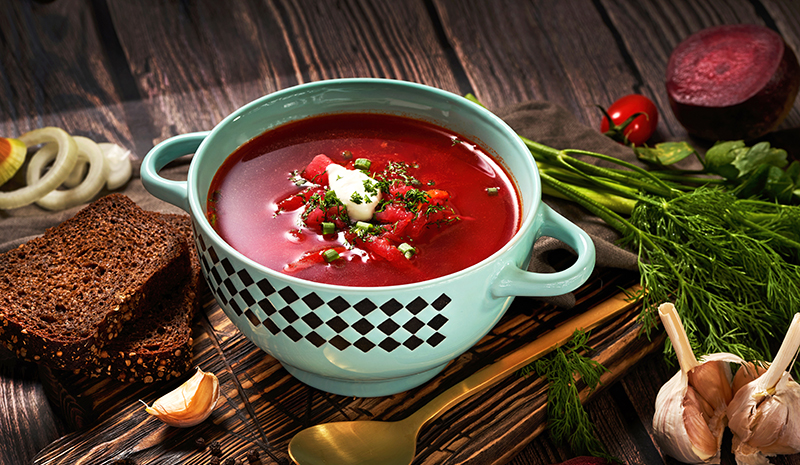
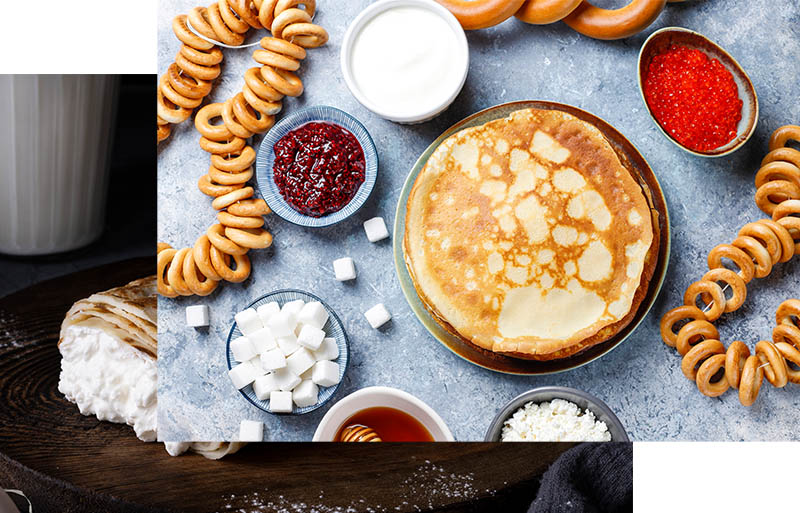
Russian cuisine is known for all possible kinds of pies. They can be made either big (pirog) or small (pirozhok). Both pirogs and pirozhoks are commonly stuffed with various fillings: meat, fish, cabbage, mashed potatoes, apples, berries or jam.
World famous are Russian pancakes. The thick ones called Oladyi (Rus: Оладьи) are great with jams, honey or sour cream. The thin ones are called Blini (Rus: Блины) and served with almost anything: sour cream, salmon, ham and cheese, honey, butter and jams. Blini are believed to be the oldest dish in Russian cuisine. Due to their round form they symbolized the sun and were traditionally prepared at the end of the winter during a week before the Lent to honor sun rebirth. The week is called Maslenitsa (Rus: Масленница).
Another traditional Russian dish is Kholodets (Rus: Холодец). It is customarily served during various celebrations and is considered the best companion of vodka. Kholodets is made from meat that picked off a boiling bone. After the meat and broth cools, they are put in the fridge for 3–4 hours to form a jelly mass. Kholodets is served cold, hence the name (Kholodets comes from the word kholod, which means cold).
Russian cuisine has its own fast food – Pelmeni (Rus: Пельмени) and Vareniki (Rus: Вареники). Pelmeni are similar to Italian ravioli with the two difference being that Pelmeni have a roughly round form and limited range of ingredients – beef, pork or fish. Traditionally they are served with butter or sour cream. As frozen Pelmeni can be perfectly preserved in the freezer and cooked in the boiling water in less than 10 minutes they are considered the simplest and quickest delicious Russian meal.
Vareniki are dumpling similar to Pelmeni but they are usually a bit bigger, have a crescent shape and stuffed with mashed potatoes, cabbage, cottage cheese, cherry or plum. Depending on the filling they can be both a main course and a dessert. Sour cream, butter or jam traditionally accompany Vareniki.
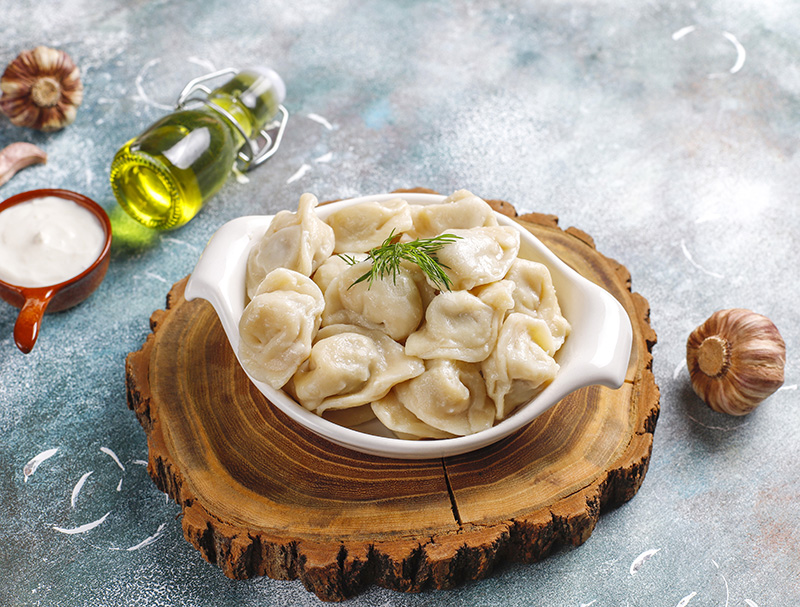
Kvas (Rus: Квас) is a traditional Russian beverage, refreshing in summer time. It has a very peculiar taste: something between Coca-Cola and beer. The main ingredient of Kvas is rye bread that is subjected to fermentation. Despite the fact that the production process is similar to beer making, Kvas contains less than 1 % of alcohol and is considered a non-alcoholic drink. Kvas is used as ingredient in cold soups like Okroshka and Svekolnik.
Mors (Rus: Морс) is a popular Russian drink prepared on the basis of sweetened berry juice mixed with water. There is a variety of Mors flavors: cranberry, blackcurrant, sea-buckthorn, raspberry, cowberry and other berries of the season. As Mors is a rich source of vitamins it can be used as a remedy, for instance, is a good cold cure.
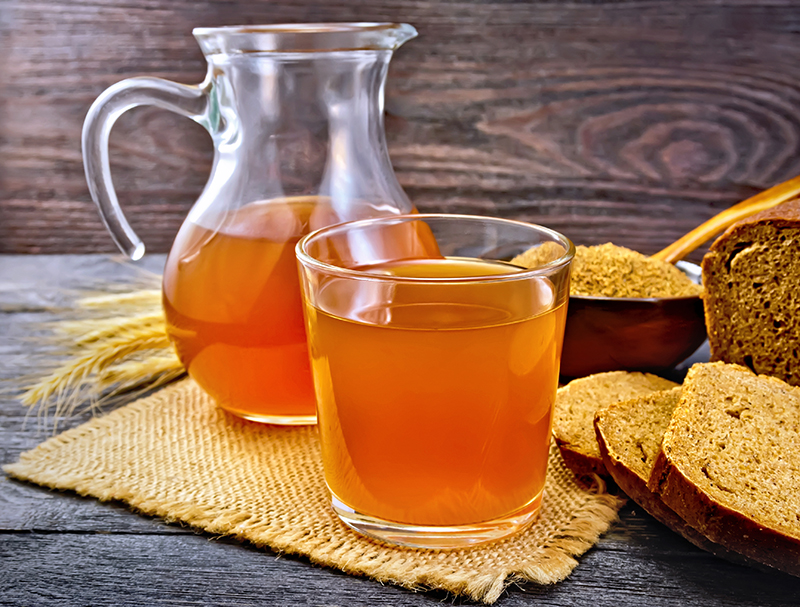
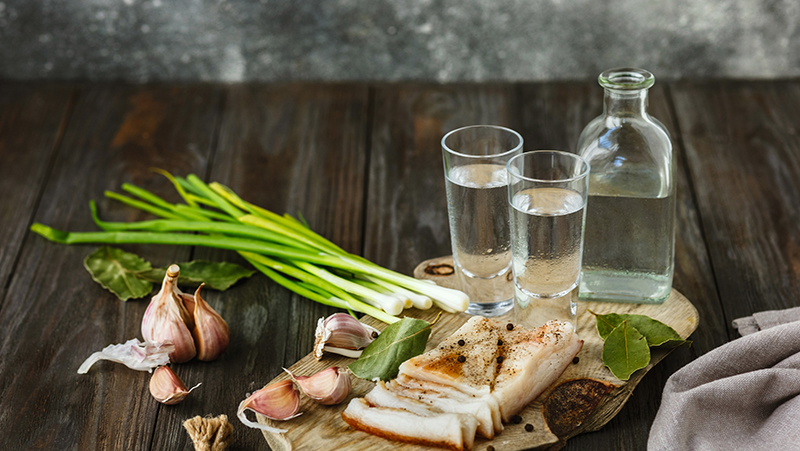
Vodka (Rus: Водка) is the most well-known Russian product. It is made, with some variation, from grain and purified spring water. Sometimes it is flavored with different ingredients ranging from hot-pepper and horseradish to berries and fruits. Vodka is served at big holidays and banquets, like the New Year’s Day, weddings and birthdays. Traditionally, Vodka is drunk chilled and followed by a bite of pickles, sauerkraut, kholodets, caviar, fatty or spicy meals.
Check out the full list of the most interesting tours in Russian cities.